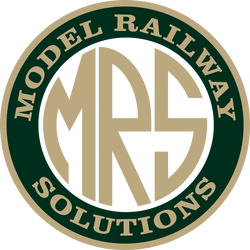
Railway Company Items LSWR LOCOMOTIVES Photos should be consulted where possible as LSWR insignia styles, spacing and positions varied considerably. The curly monogram was introduced for front splashers in 1885, the more angular one in 1893. Tender or tank lettering L&SWR in small letters came into use in 1887, the & soon being omitted. The larger letters LSWR were used from 1906. Buffer beam nos. with NO_ to left of hook and figures to right were in small size block figures at first, the larger size being introduced with the 4-6-0 locos. All items just described are black-shaded gold. From 1895-1912 approx., 4-4-0 locos had the company coat of arm on the leading splashers - this item is not included on this sheet. SR MAUNSELL PERIOD LOCOMOTIVES Most locos used the large yellow SOUTHERN, the smaller size being confined to very small tank engines. The largest size numerals (18”) were used on large tender locos and some large tank engines. The smallest size (12") were used in conjunction with the small lettering. Other locos commonly used the intermediate 14" and 16" sizes, but here there were many variations, so it is best to consult a photo if possible. Eastleigh works continued to use the gold block style buffer beam numbers. The yellow ones were used by all works including Eastleigh, where they were especially used for tender and tank back numbers, even on locos with gold front numbers. The very large front numbers were used on certain Schools class locos. The word SOUTHERN appeared high on tender or tank side with the number below it. The small section letters A, B, E or W were above the number. After 1931 the letters A, B and E were dropped. LSWR. section (E) numbers were unchanged, SECR section (A) numbers were increased by 1000, and LBSC section (B) numbers were increased by 2000. LSWR COACHES Prior to about 1900, coaches were normally lettered L&SWR. usually towards the left with the number in small size coach numbers towards the right with class lettering FIRST etc., in door waist panels. Guard and luggage doors were marked GUARDS COMPT or LUGGAGE COMPT. From about 1900-1912 small letters LSWR were used, usually in the centre of the vehicle with number towards each end. Class markings were as before except on the bogie block trains, which had the large figures 1, 2 or 3 in the lower door panels until about 1909, after which they had 1st etc. in the door waist panels. From 1912 the larger (4”) size company initials were used, in the waist panel at the centre of the vehicle with the number just to the right of the initials in the larger size coach numbers. SR MAUNSELL PERIOD COACHES The words SOUTHERN RAILWAY were normally in the top panel near the coach centre, with the number at each end in small size figures. Class designations, GUARD or LUGGAGE were in door waist panels (the latter often omitted). Some stock, mainly electric motor coaches, had class figures 1 or 3 in the lower panel of the doors instead of words. The plain yellow load markings were at the bottom of the coach side on brake vans, the word Distributed being omitted after the first few years of grouping. On high window stock the company name and numbers were in the waist panel. Seat numbers on corridor stock were at the top of the side or, if space did not permit that, on the side alongside the upper part of the windows. The larger plain yellow numbers are for end set numbers. The insignia on this sheet continued in use on some late 30's and wartime stock but from 1938 the Bulleid style word SOUTHERN was used (Sheet 10). the same sheet includes coach window markings for SMOKING and NON-SMOKING).
